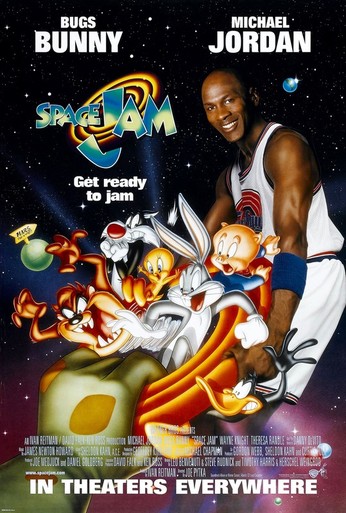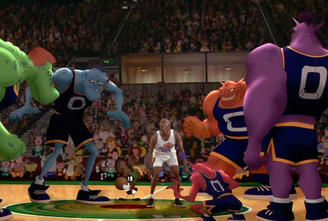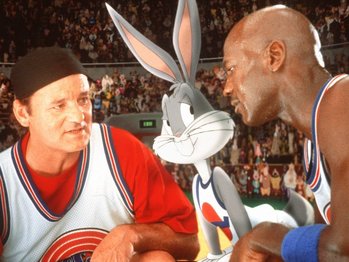Written by Zeke Perez Jr. “Breaking Down the Film” provides in-depth sports analysis of the greatest fictional teams and events in movie history. 23 years ago, Michael Jordan’s retirement coincided with a series of unfortunate events and paved the way for the most iconic and important basketball game in world history: Monstars vs. Tune Squad. In October of 1993, Michael Jordan announced his retirement from the game of basketball to follow his heart and pursue a career in baseball, spurred by the dreams of his late father. Shortly thereafter, Jordan signed a minor league contract with the Southern League’s Double-A Birmingham Barons, where he played as an outfielder. Only time would tell how much his absence from the NBA would ultimately shape a battle for Earth’s freedom. Aliens descended on Earth to capture the Looney Tunes. However, after a series of negotiations, the potential capture was put on the line as a wager for a basketball game. Billed as “The Ultimate Game”, the Tune Squad’s 78-77 buzzer-beating victory over the Monstars has been recounted numerous times; in coverage by ESPN and Sports Illustrated, and primarily in the documentary Space Jam. The Harvard Sports Analysis Collective crunched the numbers to compile a complete box score for the game, a tremendous resource that Breaking Down the Film will rely on. This analysis, however, will take a deeper dive into the factors that ultimately shaped that box score, from lineup construction to coaching and everything in between. It will consider both the good and the bad from each team, as well as other intangibles. Moron Mountain Monstars  Scouting (Talent Stealing) Woes The Monstars first stop was to Madison Square Garden to scout a game between the New York Knicks and Phoenix Suns. This decision in and of itself was a smart one. The Knicks and Suns both finished the year towards the top of their conference standings, with records of 57-25 and 56-26, respectively. During that matchup, the Monstars acquired two solid foundational pieces for their franchise’s puzzle: future Hall of Famers Patrick Ewing and Charles Barkley. That season, Ewing was averaging 24.5 points, 11.2 rebounds, and 2.3 assists per game. Barkley was also a killer, notching 21.6 points, 11.2 rebounds, and 4.6 assists. Drafting/stealing the talent from those two players was a great start to the Monstars team. However, they failed to put the best talent on the court with their other draft picks. The Monstars went on to select Muggsy Bogues, Larry Johnson, and Shawn Bradley. This is where the drop in talent begins. Bogues (10.8 p / 4.1 r / 10.1 a), Johnson (16.4 p / 8.8 r / 3.6 a), and Bradley (10.3 p / 6.2 r / 2.0 a) all posted numbers much worse than Ewing and Barkley, and other stars around the league. This translated directly to the numbers put up in the big game. Monstars Pound (Barkley) and Bupkus (Ewing) dominated their teammates in points scored. Pound contributed 6 steals and 37 points total, with 15 of those points coming from three-point range. Bupkus added another 2 steals and 34 points. Bang (Johnson) added only 6 points, while Nawt (Bogues) and Blanko (Bradley) did not score a single basket. Despite Nawt’s failure to score, he helped the team with 4 steals and a team-high 6 assists. Blanko, on the other hand, failed to contribute a single statistic all game. This is not even to suggest that Moron Mountain needed to drop Bogues, Johnson, and Bradley in favor of other talent – although Bradley was pretty worthless and it might not have been a bad idea to let him go. One major criticism of the team’s GM, Mr. Swackhammer, is that he only fielded a roster of five players, well below the NBA minimum of thirteen. Sure, some NBA teams took precautions to ensure that their players were safe once news of a mysterious illness hit the league. That doesn’t let Swackhammer off the hook for not even attempting to acquire more than five players. Especially since at least five other Nerdlucks could be seen during the game, acting as cheerleaders and servants to Swackhammer. Had the Monstars looked at using those Nerdlucks to add more talent, they would’ve put forth a better balanced team with much needed bench contribution. Roster upgrades or additions were aplenty. In the 1993-94 season, Shaquille O’Neal was in his second year in the league and was second in the league in both points and rebounds, averaging 29.3 points and 13.2 rebounds per game. A Shaq-lead Monstars team is a scary thought. Moron Mountain also could have sought more help protecting the rim and added the NBA’s leading blocker in Dikembe Mutombo of the Denver Nuggets. Bogues was second in the league in assists and that showed in the game against the Tune Squad. If the Monstars wanted to open up the floor and move the ball even more, they should have gone after assist leader John Stockton.  Statistics aside, a couple of other useful players come to mind; specifically, those who could have been of use in countering Michael Jordan. First is Joe Dumars, one of basketball’s best lockdown defenders. When Jordan was asked who the best defensive player he ever encountered was, MJ responded: “Joe Dumars – he was the toughest guy for me to drive by”. Had the Monstars selected Dumars, they may have been able to slow Jordan down. Secondly, they should have scouted Jordan’s long-time teammate Scottie Pippen. Pippen could have awarded the Monstars a psychological advantage, along with further insight on MJ. Adding Shaq, Mutombo, Stockton, Dumars, and Pippen alone would have made Moron Mountan more competitive. Even then, they would only be up to ten players and have room for three more. So top the roster off with Latrell Sprewell or Reggie Miller, David Robinson, and Hakeem Olajuwon…the Monstars would have been unstoppable. Lack of Knowledge of the Game When they were initially challenged, the Monstars didn’t even have a cursory knowledge of the game. Although they learned rather quickly, the knowledge gap hampered their preparation. The fatal flaw that ultimately doomed their team was that they overlooked Jordan because they thought he was a baseball player. Knocking Down Threes On a positive note, the Monstars’ three-point game was almost enough to give them the win. Rather than solely using their size and strength to attack the paint, the Monstars also played the perimeter and took a high number of three-point shots. Over a quarter of the 35 shots they attempted came from behind the arc. They hit all nine they attempted to, accounting for 27 of their 77 points scored. Had they relied on their hot three game a little more they may have won just by outshooting the Tune Squad, who attempted zero three-pointers. Looney Tune Land Tune Squad  Lineup Construction Just as the Monstars struggled with building a lineup, so did the Tune Squad. Despite having more than a full roster (with about twenty players suited up), the Tune Squad did not have the best possible players on the court or in the right positions. Players on the active roster who were used incorrectly While Daffy Duck contributed 4 points and a key steal late in the game, there remains some confusion about his role on the team. Size was in short supply on the roster, forcing Daffy into the starting Power Forward role despite being much too small to contribute as a Power Forward. It was also quite interesting to see Michael Jordan excel as a Center, rather than at his natural Shooting Guard position. This move made sense, however, as Jordan was easily the tallest player on the team. In Looney Tune Land, Jordan becomes the equivalent of a Kristaps Porzingis, a powerful big man who also doubles as a skilled ball-handler and a smooth shooter. Players on the active roster who definitely should not have been Without question, Stan Podolak – Jordan’s obnoxiously overbearing publicist – should not have been allowed anywhere near the team. Although he scored a fluke basket in the game, he was out of shape, uncoordinated, and not fit to make a basketball roster in any galaxy. It is very sad to say, but Sniffles the adorable mouse probably should have been left off of the roster as well. One anonymous NBA scout said of Sniffles, “I don’t know that he has any skill other than a big heart”. Sniffles possessed all the energy and drive to always try really, really hard to be good at basketball, yet he lacked the necessary size to compete against Moron Mountain. Players left off of the active roster Aside from Jordan, the Tune Squad had very little height on the roster. Surprisingly, a number of tall, strong Looney Tunes were seen in attendance at the game, begging the question of why they were not invited to the Tune Squad’s Draft Combine. Toro the Bull likely could have been an excellent Power Forward who would provide lockdown defense, as evidenced when he charged the court and knocked a Monstars’ player into the air. The same can be said of Junior Bear, Gossamer (the hairy, orange, heart-shaped guy), and Gruesome Gorilla. Strength and Conditioning The Tune Squad’s strength and conditioning coach was a Richard Simmons VHS tape…enough said.  Poor Coaching, Leadership, and Staffing As legendary as Michael Jordan was as a player, he had various shortcomings as a coach (and as a GM/owner if you ask the Charlotte Bobcats/Hornets). Jordan struggled in setting a game plan and drawing up plays. Late in the game, down by 1, the only play call he can muster is “somebody steal the ball, give it to me, and I’ll score before the time runs out”. No X’s and O’s, no call for man or zone defense, no half-court press. Just a general ask for someone to steal the ball. Had Bill Murray not stepped in to give Daffy Duck further advice on a potential turnover play, the Tune Squad very well might have lost thanks to Jordan’s poor play calling. Jordan got mixed reviews for his motivational tactics. His motivating pre-game speech was simply, “Let’s just go out and have fun”, as if the Looney Tunes weren’t playing to avoid an eternity of slavery. Maybe he was trying for a less assertive and more calming approach, but it didn’t work. The Tune Squad came out to a sluggish start and an abomination of a first half. To his credit, he did respond at half time to get his team back on track by offering a water bottle full of his “Secret Stuff”, only to reveal later in the game that there was no secret stuff, but rather that the strength and talent was in the Looney Tunes all along. It’s painfully obvious that the Tune Squad didn’t hire a team equipment manager either. Suiting up for the game, Tweety inexplicably uses eye black and Daffy prepares to exit the locker room wearing a suit of armor, boxing gloves, an inflatable pool toy around his waist, and cleats. Locker Room Issues Although the Tune Squad should have been strongly united as they were literally playing to avoid a life of captivity, the locker room was a divisive place. The rifts between several players on the team manifested in a number of in-game and off-the-court issues. In one of the most highly publicized sports-related biting incidents (occurring just a few years before Mike Tyson bit Evander Holyfield’s ear), Sylvester attempted to eat Tweety mid-play, leading to a costly turnover and tension between the two rival teammates. Another consistent factor in the locker room divide was Daffy Duck’s general animosity and arrogance. Daffy was the DeMarcus Cousins of that team, frequently drawing rumors of being hard to play with and hard to coach. Daffy yearned to be a superstar and thus felt slighted by the identity as a role player he fell into. Spats with his peers during practices and team meetings were a regular problem. Finally, the team was often so disjointed that knowledge sharing which would have benefitted the team did not occur. Team leaders failed to tell player/coach Michael Jordan that Looney Tune Land was exempt from all rules of physics that prevail over the human universe, until only ten seconds remained in the game. Sharing this vital information earlier certainly would have allowed for more freedom of play and increased scoring opportunities. Intangibles  Poor Officiating Head referee Marvin the Martian put forward the most blatantly pathetic display of officiating in the existence of basketball. He may have overcompensated in attempting to be fair, feeling the pressure of being both an alien like the Nerdlucks and a citizen of Looney Tune Land. Regardless of the reason, he went too far in his effort to remain unbiased, failing to call a single foul in the game. This was not merely a case of “letting the players play”. No. Over twenty-five different types of technical fouls, flagrant fouls, and, to be honest, misdemeanors and felonies, went unchecked by Ref Marvin. Offenses include a backhand on the first play of the game, multiple dogpiles, a slew of punches, kicks, bites, and heatbutts, breathing fire to roast an opponent, defensive holding, a flying elbow drop, using one opponent as a golf club to hit another opponent, and a motorized scooter being driven onto the court. The most egregious violations were three firearms that made it onto the court, with two of those being discharged during play. Yosemite Sam brought the first gun onto the court, aiming at an opponent in transition. Later, Yosemite Sam drew and fired another firearm, this time along with Elmer Fudd in a Pulp Fiction-esque manner. The only time Ref Marvin attempts to enforce any kind of rule at all is when he threatens the Tune Squad with forfeiture of the game if they cannot find a fifth player after injuries depleted their roster. The blame can’t be placed solely on Marvin, however. The regulation number of officials for an NBA game is three: one head referee/crew chief and two officials. With the number of fouls that occurred on the court, it can’t be expected that Marvin would have caught all of them (although he’s not off the hook for failing to catch one). Perhaps two more officials would’ve helped the pace and the play of the contest. Injuries Injuries took their toll on the game as well, especially on the Tune Squad side. The Tunes had racked up over a dozen player injuries by halftime (not including another to their cheerleader, Granny). The weight of a physical game and their inability to stay healthy undoubtedly altered their results on the court, in particular those in the first half. Conclusion  Nothing sparks the imagination more than the question “what if?” and the sports world is overflowing with what if scenarios. What if the Red Sox never traded Babe Ruth to the Yankees? What if John Elway followed through on his threat to play baseball instead of football? What if Michael Jordan never retired in 1993? The fate of an entire universe rested on questions like these, as “The Ultimate Game” could have swayed in any number of directions if things were done differently. If Michael Jordan never announced his first retirement, the Nerdlucks surely would have scooped up the Looney Tunes’ savior and cruised to an easy victory, enslaving the Tunes’ entire race. One of the most beautiful aspects of sports is that games unfold in such a way that no movie script could be written as perfectly. Changes could have been made by either team that would have led to a different outcome. External factors could have pushed the game in a million other directions. Instead, when the Monstars took on the Tune Squad, we were treated to an instant classic. Even if you think about it every night and day, no other scenario can top the one that really happened. The one that made you believe you could fly.
0 Comments
Leave a Reply. |
Archives
March 2025
|
|
© 2012-2025, Nerds That Geek LLC.
All Rights Reserved. |
uWeb Hosting by FatCow


 RSS Feed
RSS Feed